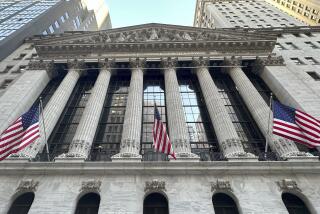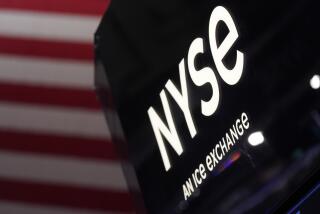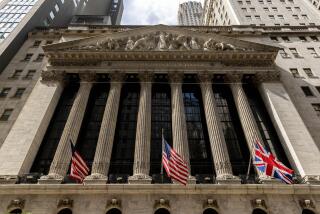Gold Closes Above $440
- Share via
Gold on Tuesday closed above $440 an ounce for the first time in 16 years, pushed higher by a troubling inflation report and by continuing worries about the dollar’s latest slide.
Some gold enthusiasts also are bullish about the launch of new investment funds that would make it easier for average investors to own or trade the metal.
Gold’s 2004 rally has carried the price up 17% since mid-May. Year to date, gold is up nearly 6%, after a 19.5% rise in 2003 and a 25% gain in 2002.
Futures for December delivery rose $3.20 to $440.20 an ounce in New York on Tuesday. It was the highest closing price since August 1988.
Gold’s traditional role in investment portfolios has been as an inflation hedge -- meaning the metal is expected to hold its value in times of rising inflation.
The surge in energy prices this year has raised concerns about inflation pressures in the economy. Those fears were compounded Tuesday when the government said its gauge of wholesale prices jumped 1.7% last month, the biggest increase in almost 15 years.
But the main driver of gold prices since 2001 has been the slide in the dollar against other major currencies, analysts say. That has encouraged some global investors to trade out of dollars and into gold.
“People fear a weakening dollar,” said Kathleen Camilli, founder of Camilli Economics in New York. “When they see a lack of strength in the currency, they go to gold as flight to quality.”
What’s more, because gold is priced worldwide in dollars, it becomes cheaper for foreign buyers as their own currencies rise in value.
In recent weeks the dollar has hit multiyear lows against the euro and other key currencies.
On Tuesday the euro rose again, after European finance ministers failed to ask the European Central Bank to sell the currency to stem its advance. The euro ended at $1.296 in New York, just below the record high of $1.298 set Friday.
“Gold is just keeping up with the dollar’s drop,” said Dennis Eich, a trader at Chicago-based brokerage Peregrine Financial Group. “The dollar is going to constantly depreciate” for the U.S. to be competitive with Asia and Europe, he said.
A weaker dollar makes U.S. goods cheaper for foreign buyers. Some economists say the dollar must decline further to narrow the record trade gap the United States has with the rest of the world.
New gold-backed investment funds also may boost demand for the metal, analysts said. In effect, the funds would allow investors to own gold without having to take physical possession of the metal.
The World Gold Council is launching an exchange-traded fund designed to track the performance of bullion. The Securities and Exchange Commission on Tuesday cleared the fund for sale. Its shares are expected to begin trading soon on the New York Stock Exchange under the ticker symbol GLD.
UBS Investment Bank is handling the fund’s sale.
The World Gold Council is funded by some of the world’s biggest producers, including Newmont Mining Corp. and AngloGold Ashanti Ltd.
The fund may boost demand for gold by as much as 550 tons, or about 18 million ounces, in the first year, London-based research company Virtual Metals said in August.
San Francisco-based Barclays Global Investors, which created the popular iShares exchange-traded funds, also plans to introduce a gold fund soon. It is expected to trade on the American Stock Exchange under the ticker symbol IAU.
More to Read
Inside the business of entertainment
The Wide Shot brings you news, analysis and insights on everything from streaming wars to production — and what it all means for the future.
You may occasionally receive promotional content from the Los Angeles Times.










